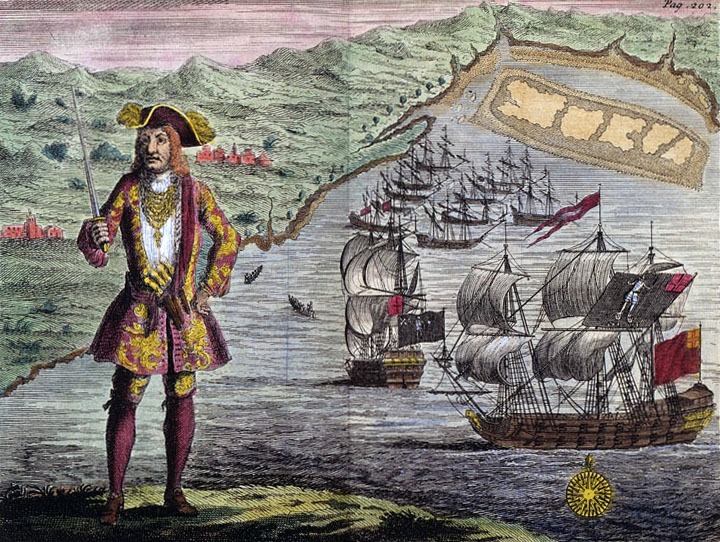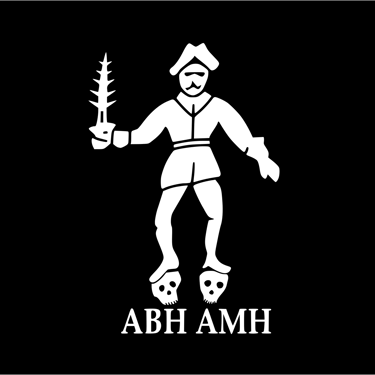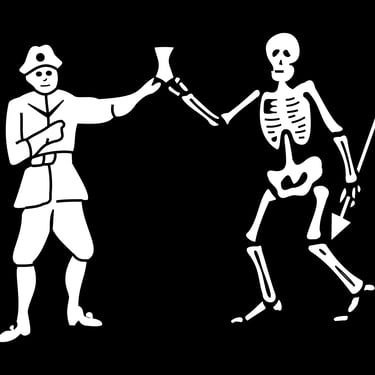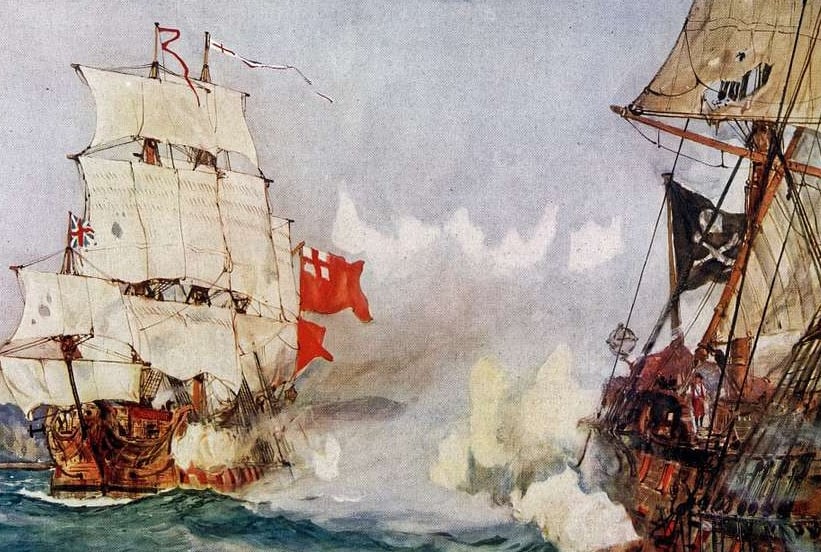‘No, a merry life and a short one shall be my motto’. Black Bart.
Thus remarked a certain Captain Bartholomew Roberts, a notorious seventeenth-century pirate. The low wages and hard labour in other areas of life contrasted unfavourably with the possibilities of ease, plenty, liberty and power. Roberts, like the notorious Henry Morgan, was a Welshman born in Pembrokeshire and grew up to be a tall, dark, ingenious and daring seaman.
Richard Bird
3/3/202411 min read


Transformation of a seaman
For a time he led the hard but honest life of a sailor trading to the Guinea coast, but in 1719 he had the unfortunate luck of being captured by Davis, another pirate captain. Davis forced Roberts to lead a life of piracy, although it is important to note that Roberts was initially against this criminal way of life and would have certainly abandoned it if given the chance. But after a while, his desire for advancement and success overpowered his conscience and caused him to accept his fate as a pirate. Now, when Davis died in action, the pirate crew chose Roberts as their skipper. The reasons given were that he was a man of courage, skilled in navigation, and seemingly the one best equipped to handle the responsibility of their lives and of the ship.
Rise to infamy
So the pirate ship sailed south along the Guinea coast with her new commander, captured a Dutch Guinea ship, emptied her of everything they fancied, sent her on her way again, and two days later took an English ship, persuading her crew to join Roberts’ ship. The prize was burned, and Roberts, with a now much bigger company, set sail for the island of St. Thomas, in the South Atlantic. Not achieving any luck in the area, they resolved by vote to make for Brazil. After a twenty-eight-day voyage across the Atlantic they arrived off the South American shore and for nine weeks or so cruised about unsuccessfully, taking care to keep out of sight of land. However, whilst making their way to the West Indies, they unexpectedly fell in with a fleet of forty-two Portuguese ships of Bahia who were bound for Lisbon, and were now waiting for two 70-gun men-of-war to escort them home.
The sight was enough to make any self-respecting pirate dribble. His one problem was that he was but a single ship against so many, amongst whom were some powerful vessels. But being a true disciple of Derring-do, he was minded to have a try. Among the various challenges faced by these pirate adventurers, readers may have noted the remarkable cunning exhibited by these lawless individuals. The combination of skill and brutality may seem contradictory, but pirate captains were able to demonstrate both ingenuity and force when necessary. While they were willing to use violence when required, they also relied on cunning strategies.
Roberts devised such a cunning plan. He got his ship in their midst but kept concealed. He then took his ship close to one of the biggest Portuguese and hailed her to send her master aboard quietly. If the Portuguese should show the slightest resistance, or make any signal of distress, he would show them no mercy. This cool impudence succeeded: when the master came on deck and witnessed the sudden flash of pirate cutlasses of the men who had previously been hidden, he naturally submitted. The Portuguese captain then boarded the pirate ship as requested. Roberts saluted him in a friendly manner and told him he and his crew were gentlemen of fortune. All they desired from him was to be informed as to which was the richest ship of the fleet. If the captain informed them correctly, then he should be allowed to go back to his ship in safety: but if not, he must expect instant death. Fair enough methinks.
So, probably reluctantly, the Portuguese captain pointed out a 40-gun vessel which had a crew of 150 men. She appeared far too big a task for Roberts to tackle, but being the sporting fellow that he was, made towards her. As they came alongside, the pirate ordered the Portuguese prisoner to hail her and inquire after the commander’s health and invite him on board, as a matter of importance was waiting to be imparted to him. How many times have we heard that one? The reply came that the commander would come presently. Roberts, observing signs of unusual activity on board her, was not fooled, he poured a heavy broadside into her, then ran his ship right alongside in the time-honoured way grappled and boarded her. In a short space of time, she had been captured and quickly plundered of her riches.
Revelry and challenges on Devil’s Island
Now the pirates needed to distance themselves and seek a secure haven to indulge in revelry with their acquired spoils. They decided on Devil's Island, situated on the Surinam River in Dutch Guiana, where they received a warm reception from the governor and locals. However, facing a shortage of provisions, they encountered a sloop in the river. After seizing the vessel, its crew revealed sailing in the company of a brigantine loaded with provisions. Good news indeed, Captain Roberts deemed the matter sufficiently important to warrant personal attention. He assumed command of the captured sloop, accompanied by forty men, leaving the pirate ship behind with confidence in its safety. Roberts anticipated a brief absence, confident of finding brigantine promptly and returning with its valuable cargo.
Poor Roberts was unlucky. He didn’t see the Brigantine, despite eight days of sailing. He came to anchor off the coast somewhere and sent a boat ashore to inform their shipmates left behind in the Surinam River. The boat was also to bring back provisions to the sloop: but when she returned, she brought no provisions and the unwelcome knowledge that the lieutenant of the pirate ship had run off with her. He had to act. Provisions and water they must have at all costs, and so they must make for the West Indies.”
They had not gone far, however, before they fell in with a couple of sloops, which they captured. These afforded them the necessary supplies. A few days later they also captured a brigantine and then proceeded to Barbados. Off Barbados they met a 10-gun ship heavily laden with cargo from Bristol which they duly plundered, but after three days allowed her to proceed. But when the latter reached land and informed the governor of her adventure, a 20-gun ship with eighty men, under the command of Captain Rogers, was sent to seek out the pirates. In two days they came up with her, and the two craft drew near. Roberts as usual fired a blank shot for the stranger to heave to and was very surprised to observe that instead of striking his colours straight away she returned his shot with a broadside. A brisk engagement which Roberts was getting the worst of. Abandoning some cargo to lighten his ship, Roberts made off as fast as he could.
After leaving Barbados, the pirate Captain Roberts sailed to Dominica in the Caribbean Sea. He traded some of his cargo with the locals for provisions and watered his ship. While there, he met fifteen Englishmen who had been stranded on the island by some Frenchmen who had captured their ship. Roberts convinced them to join him and his crew, which was a valuable addition to their strength.
However, Roberts' ship was in bad shape, and it needed to have its bottom scrubbed. So, he sailed southwards towards the Grenada Islands to take care of it. He didn't waste any time and was immediately put to sea after the cleaning. It turned out to be a wise decision because the Governor of Martinique received information that the pirate was nearby, and he sent two sloops to catch him. Fortunately, Roberts had already departed the very night before the sloops arrived.
Setting a northerly course, the pirate now proceeded towards Newfoundland. His ship was well-cleaned, so she could sail at her best pace. He arrived off the Banks in June of 1720, and entered the harbour of Trepassi with the black pirate’s flag at her masthead, with drums beating and trumpets sounding. Twenty-two ships were lying in that harbour as Roberts came in, but as soon as they realised what sort of a visitor was amongst them, the crews forsook the ships, and Roberts, with his men, destroyed them by burning or sinking, and then pillaged the houses ashore, behaving like madmen and fiends let loose.”
Roberts retained a single ship from the fleet, originating from Bristol. After leaving the harbour, he encountered and destroyed ten French ships off the Newfoundland Banks, sparing one for his use, named the Fortune. The Bristol ship was handed over to the Frenchmen. Subsequently, Roberts, cruising in the shipping lanes, secured significant prizes. He then sailed for the West Indies, stocked up on provisions, and decided to hasten towards the Guinea coast, where past successes awaited.
Changing ships
En route, they encountered a French ship, and Roberts, deeming it more suitable for piracy than his own, arranged an exchange of ships with the French skipper. Facing navigation errors, the crew suffered from water shortages, reducing them to one mouthful a day. Famine further afflicted them, resulting in crew fatalities and extreme weakness. Deprived of fluid for drinking, the situation worsened until, fortunately, they discovered seven fathoms of water. Dropping anchor, the ship's boat was dispatched, providing a lifeline as it returned with ample drinking water.
Despite this reprieve, the crew, hardened and ungrateful, resumed their lawless activities at sea. They encountered a ship providing necessary provisions and subsequently a brigantine, offering both supplies and a mate who joined their ranks. Upon learning that the governor had dispatched two ships to capture them, they sought revenge. Exploiting the illegal trading practices of Dutch ships near Martinique, they engaged in impudent and cruel acts, taking advantage of the customary signal system involving hoisting jacks and trading contests between inhabitants and approaching ships.
The artful Roberts, always ready with some new device, was well aware of this custom, so when he arrived off the island he hoisted the Dutch jack and waited. The inhabitants of Martinique saw it and came off in their craft as fast as they could. As each man came on board he had him killed until there were only left those who had remained in the small ships which had come for the cargo. All these ships, to the number of twenty, he burned, excepting one: and into this one ship, he put the survivors and sent them back to Martinique with the doleful news. ”
It was a cruel, heartless trick and the basest of all methods of revenge. Roberts’ ships were then put to sea once more. They found themselves, after a successful period, well supplied with everything, they would indulge themselves with some hard drinking: apparently, it was deemed a crime among them not to be in this drunken state. Finding their wealth diminishing they set a course across the South Atlantic once more to the Guinea coast to forage for gold. They fell in with two French ships, of which one was a 10-gunner and the other a 75. The former carried sixty-five men and the latter seventy-five. But so soon as these cowards recognised the black flag they surrendered. So, taking the two prizes with them, the pirates went on to Sierra Leone. One of the new ships Roberts named the Ranger, the other he used as a store ship.”
Cat and mouse games with the Swallow
After six more weeks spent at Sierra Leone in excesses, they put to sea, and after more captures and further debaucheries. Fun and frivolity had made a big hole in their capital, so that if they were to keep alive they must get to work again. So it continued, they held up unprotected merchant ships, relieved them of their cargoes and then burnt or sunk them. But the time of reckoning was at hand, for H.M.S. Swallow 50, and another man-of-war had now been sent to capture both Roberts and his craft. They had obtained definite news about the likely whereabouts of the pirates and were going to handle the matter firmly. Just a little to the south of the Equator, where the “line” touches the west coast of Africa, is a bold promontory known as Cape Lopez. Off this point lay Roberts.





A gallery of Black Bart’s flags. Courtesy of Wikipedia.
The end is nigh, February 1722.
The Swallow came up as fast as she could to Robert’s known position. On February 5th the pirates saw this strange sail in the offing, so Roberts sent one of his ships the Ranger under Captain Skymes to chase her and bring her back. The pirate had heard that two men-of-war were sent out to seek him, but so far had successfully escaped them, but he became over-confident and careless. And in the present circumstance, he judged the Swallow to be merely one more unhappy merchantman that was to add to his list of victims. But when the pilot of the Swallow saw the detached pirate craft approaching, he altered his course and ran away from her, but he gave her a good long run for her trouble, and managed to allow her gradually to overtake the man-of-war. But this was not until the pirate had got well away from her mother ship.
As the pirate ship came up, full of confidence that the prize would shortly be hers, she hoisted out her black flag and then fired. It was now too late, they discovered that this was a man-of-war and much more than a match for the pirate. Robert’s ship was too far off to give any assistance, and so, seeing that resistance would be futile, she cried for quarter. This was granted and her crew made prisoners, having already lost ten men killed and twenty wounded. The Swallow had not received one single casualty.
On February 10th Roberts onboard the Royal Fortune was still lying near the Cape, when they could see the masts of the Swallow as the ship bore away to round the Cape. Roberts was below having breakfast, and some of the crew came down to inform him of the sight. But Roberts was far more interested in his meal than in the ship was not concerned, after all she might be a Portuguese craft, or a French slaver, or it might be their own Ranger coming back. But as the ship came it dawned on the pirates that it was the man-of-war Swallow. Undeterred, Roberts berated those who were disheartening his men as cowards. Even if she were the Swallow, what did it matter? Were they afraid to fight her?
If there was any doubt in the mind of the man on board the pirate ship, it was quickly settled when they saw the Swallow ship preparing for an attack by hoisting up its ports and readying its guns. Roberts, realised it was time to take action. He quickly got his ship moving, ordered his men to arms, and showed no sign of fear, dropping an occasional oath. The pirate ship’s sails were unfurled, and it began to move away. Though Roberts was not pleased to have to interrupt his breakfast, he decided to run before the wind to escape the Swallow.
The two ships were coming closer to each other, leaving no time for thinking about tactics. Roberts had to make a quick decision. His plan was to pass very close to the Swallow, with full sail, and receive her broadside before returning a shot. If the pirate ship got disabled, or if its masts and sails were shot away, they would run it ashore. Everyone could then shift for themselves among the natives. If this plan failed, Roberts intended to get his ship alongside the Swallow and blow both ships up together. Unfortunately for Roberts his own men were either drunk or only passively courageous. They were not the alert and keen crew who are likely to win any engagement.
Vainly dressed in a rich crimson damask waistcoat and breeches, a red feather in his hat, a gold chain round his neck with a diamond cross depending, he stood on his deck, sword in hand, and two pairs of pistols hanging at the end of a silk sling flung over his shoulders. The very picture of a bold pirate. When his ship closed with the Swallow, he received her fire and hoisted his black flag, returning the man-of-war’s fire. He set all the sail he could, and, as the ship tore through the water, blazed away at the Swallow. But either through the wind shifting or else through bad steerage in the excitement of the contest, his sails, with the tacks down, were taken aback, and for a second time the Swallow came quite close to him.
There might have been a very desperate fight, but a grape shot struck him in the throat. He laid himself on the tackles of one of the ship’s guns. The helmsman seeing him there, and that he was wounded, ran towards him and swore at him, bidding him stand up and fight like a man. Realising that his chief was already dead, he burst into tears. The bold and resourceful Roberts’ lifeless body was thrown into the water cloaked in a ship’s sail and weighted down, as he had wished to be buried with his arms and ornaments, his four-year career of piracy at an end.
The pirate ship was now soon captured, and the crew arrested. The latter were strictly guarded while on board the man-of-war, and were taken to Cape Corso Castle on the Afican coast, where they underwent a long trial. Like many of the old smugglers, these pirates remained defiant and unrepentant, but after some experience of the dull confinement in the castle and the imminence of death, they changed their disposition. Fifty-two were found guilty and one Harry Glasby was acquitted.
The captain of the Swallow was knighted for the exploit (capturing 187 pirates), and afterwards became famous as Admiral Sir Chaloner Ogle.
Sources:
Boston Newsletter. August 1720.
A General History of Pyrates. 1724

